
The Mosaic Company Earnings Conference Call – Second Quarter 2016 August 2, 2016 Joc O’Rourke, President and Chief Executive Officer Rich Mack, Executive Vice President and Chief Financial Officer Dr. Mike Rahm, Vice President Market and Strategic Analysis Laura Gagnon, Vice President Investor Relations

Safe Harbor Statement This document contains forward-looking statements within the meaning of the Private Securities Litigation Reform Act of 1995. Such statements include, but are not limited to, statements about the Wa’ad Al Shamal Phosphate Company (also known as MWSPC) and other proposed or pending future transactions or strategic plans and other statements about future financial and operating results. Such statements are based upon the current beliefs and expectations of The Mosaic Company’s management and are subject to significant risks and uncertainties. These risks and uncertainties include but are not limited to risks and uncertainties arising from the ability of MWSPC to obtain additional planned funding in acceptable amounts and upon acceptable terms, the timely development and commencement of operations of production facilities in the Kingdom of Saudi Arabia, the future success of current plans for MWSPC and any future changes in those plans; difficulties with realization of the benefits of our long term natural gas based pricing ammonia supply agreement with CF Industries, Inc., including the risk that the cost savings initially anticipated from the agreement may not be fully realized over its term or that the price of natural gas or ammonia during the term are at levels at which the pricing is disadvantageous to Mosaic; customer defaults; the effects of Mosaic’s decisions to exit business operations or locations; the predictability and volatility of, and customer expectations about, agriculture, fertilizer, raw material, energy and transportation markets that are subject to competitive and other pressures and economic and credit market conditions; the level of inventories in the distribution channels for crop nutrients; the effect of future product innovations or development of new technologies on demand for our products; changes in foreign currency and exchange rates; international trade risks and other risks associated with Mosaic’s international operations and those of joint ventures in which Mosaic participates, including the risk that protests against natural resource companies in Peru extend to or impact the Miski Mayo mine; changes in government policy; changes in environmental and other governmental regulation, including expansion of the types and extent of water resources regulated under federal law, greenhouse gas regulation, implementation of numeric water quality standards for the discharge of nutrients into Florida waterways or efforts to reduce the flow of excess nutrients into the Mississippi River basin, the Gulf of Mexico or elsewhere; further developments in judicial or administrative proceedings, or complaints that Mosaic’s operations are adversely impacting nearby farms, business operations or properties; difficulties or delays in receiving, increased costs of or challenges to necessary governmental permits or approvals or increased financial assurance requirements; resolution of global tax audit activity; the effectiveness of Mosaic’s processes for managing its strategic priorities; adverse weather conditions affecting operations in Central Florida, the Mississippi River basin, the Gulf Coast of the United States or Canada, and including potential hurricanes, excess heat, cold, snow, rainfall or drought; actual costs of various items differing from management’s current estimates, including, among others, asset retirement, environmental remediation, reclamation or other environmental regulation, Canadian resources taxes and royalties, or the costs of the MWSPC, its existing or future funding and Mosaic’s commitments in support of such funding; reduction of Mosaic’s available cash and liquidity, and increased leverage, due to its use of cash and/or available debt capacity to fund financial assurance requirements and strategic investments; brine inflows at Mosaic’s Esterhazy, Saskatchewan, potash mine or other potash shaft mines; other accidents and disruptions involving Mosaic’s operations, including potential mine fires, floods, explosions, seismic events, sinkholes or releases of hazardous or volatile chemicals; and risks associated with cyber security, including reputational loss, as well as other risks and uncertainties reported from time to time in The Mosaic Company’s reports filed with the Securities and Exchange Commission. Actual results may differ from those set forth in the forward-looking statements. 2

Summary 3 Mosaic is Well Positioned to Weather the Cycle Market Environment Mosaic’s Actions Capital Stewardship

Market Update

Good Demand Fundamentals 5 No change in 2016 forecast ranges Bunching of demand expected in second half 2016 Shipments projected to accelerate in 2017 65‐66 66‐68 30 35 40 45 50 55 60 65 70 00 01 02 03 04 05 06 07 08 09 10 11 12 13 14 15 16F17F Global Phosphate ShipmentsMil Tonnes DAP/MAP/NPS/TSP Source: CRU and Mosaic 59‐60 61‐63 25 30 35 40 45 50 55 60 65 00 01 02 03 04 05 06 07 08 09 10 11 12 13 14 15 16F17F Global PotashShipmentsMil Tonnes KCl Source: CRU and Mosaic

Good Demand Fundamentals 6 Corn, soybeans and wheat prices are making headlines But El Niño left its mark on several commodities Brazil especially benefits from high sugar, cotton and coffee prices 10 11 12 13 14 15 16 17 18 19 20 21 Sep-15 Dec-15 Mar-16 Jun-16 US$ CWT Source: NYMEX Sugar Prices Daily Close of Nearby Option 1,900 2,000 2,100 2,200 2,300 2,400 2,500 2,600 2,700 2,800 2,900 Sep-15 Dec-15 Mar-16 Jun-16 Rngts Tonne Source: CRB Malaysian Palm Oil Prices Daily Close of Nearby Option 100 110 120 130 140 150 160 Sep-15 Dec-15 Mar-16 Jun-16 US$ CWT Source: NYMEX Coffee Prices Daily Close of Nearby Option 55 58 60 63 65 68 70 73 75 Sep-15 Dec-15 Mar-16 Jun-16 US$ CWT Source: NYMEX Cotton Prices Daily Close of Nearby Option

Good Demand Fundamentals 7 Strong demand drivers: record or near‐record local currency prices for soybeans, corn, sugar and coffee 2016 DAP/MAP/NPS/TSP imports forecast to total 5.1‐5.3 million tonnes 2H Phosphate imports of 2.9 million tonnes up ~300,000 tonnes from last year 2016 MOP imports forecast to total 8.4‐8.6 million tonnes 2H MOP imports of 4.6 million equal to the 2015 record 1.0 1.5 2.0 2.5 3.0 3.5 First Half Acutal Second Half Actual/Forecast Mil Tonnes Source: ANDA and Mosaic Brazil Phosphate Imports 2014 2015 2016 2.0 2.5 3.0 3.5 4.0 4.5 5.0 First Half Acutal Second Half Actual/Forecast Mil Tonnes Source: ANDA and Mosaic Brazil Potash Imports 2014 2015 2016
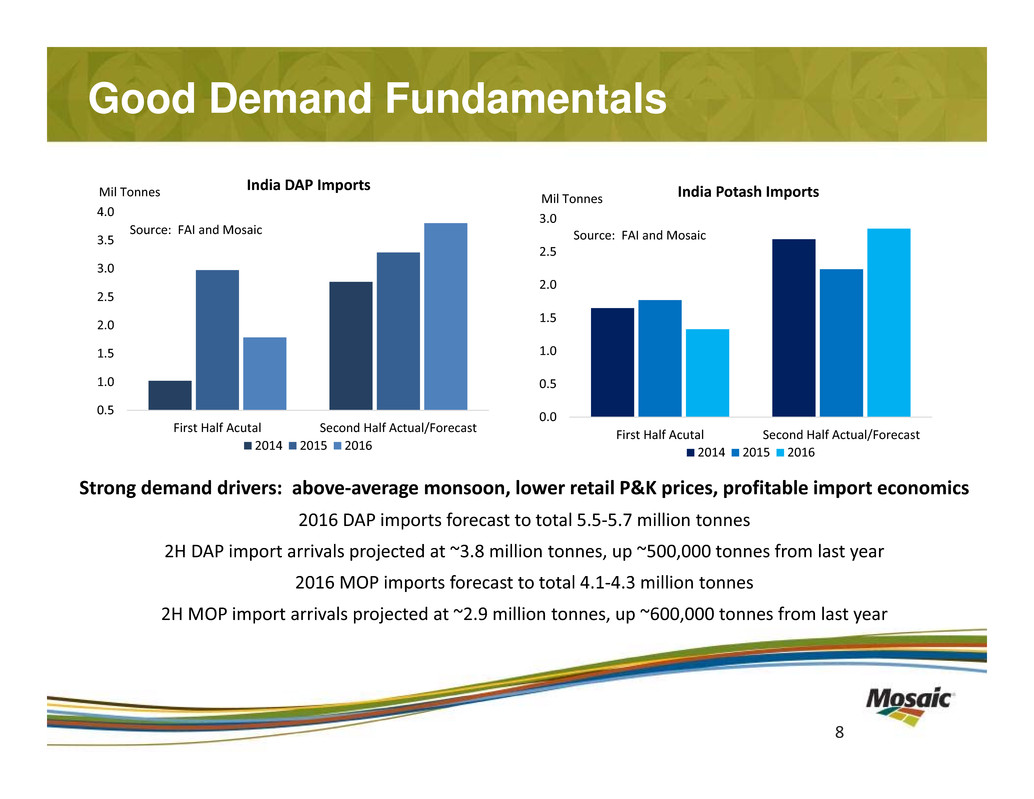
Good Demand Fundamentals 8 Strong demand drivers: above‐average monsoon, lower retail P&K prices, profitable import economics 2016 DAP imports forecast to total 5.5‐5.7 million tonnes 2H DAP import arrivals projected at ~3.8 million tonnes, up ~500,000 tonnes from last year 2016 MOP imports forecast to total 4.1‐4.3 million tonnes 2H MOP import arrivals projected at ~2.9 million tonnes, up ~600,000 tonnes from last year 0.5 1.0 1.5 2.0 2.5 3.0 3.5 4.0 First Half Acutal Second Half Actual/Forecast Mil Tonnes Source: FAI and Mosaic India DAP Imports 2014 2015 2016 0.0 0.5 1.0 1.5 2.0 2.5 3.0 First Half Acutal Second Half Actual/Forecast Mil Tonnes Source: FAI and Mosaic India Potash Imports 2014 2015 2016

FX Impact on Supply 9 FSU exporters have benefited from a collapse of local currencies Russian ruble and Belarussian ruble are down 45% and 50% since 2014 Q1 Brazil potash price has declined 60% in dollars but is off just 5% in Belarussian rubles since January 2012 40 50 60 70 80 90 100 110 Jan-14 Jul-14 Jan-15 Jul-15 Jan-16 Jul-16 Index Source: CRB Key Potash Exporter Exchange Rates 2014 Q1=100 Canadian Dollar Russian Ruble Belarus Ruble 0 750 1500 2250 3000 3750 4500 5250 6000 200 250 300 350 400 450 500 550 600 Jan-10 Jan-11 Jan-12 Jan-13 Jan-14 Jan-15 Jan-16 1000 Belarus Rubles Tonne US$ Tonne Source: Argus FMB and CRB MOP Price c&f Brazil Port US$ Tonne 1000 Belarussian Rubles Tonne

Managing Costs and Capital • $500 million Expense Reduction • +$75 million from Support Functions • Asset Optimization • Lower Capital Spending 10

Multiple Actions to Reduce Costs 11 *Production costs are reflective of actual costs, excluding realized mark‐to‐market gains and losses. These costs are captured in inventory and are not necessarily reflective of costs included in costs of goods sold for the period. $67 $73 $100 $74 $36 $19 $‐ $20 $40 $60 $80 $100 $120 Esterhazy Belle Plaine Colonsay EnterpriseC a s h c o s t s i n c l u d i n g r o y a l t i e s , e x c l u d i n g r e s o u r c e t a x e s a n d r e a l i z e d d e r i v a t i v e g a i n s / ( l o s s e s ) Cash Costs by Mine H1 2016 Brine Cash costs including royalites, excluding resource taxes, brine and realized derivative gains/(losses) average

Low Cash Cost Opportunity 12 *Production costs are reflective of actual costs, excluding realized mark‐to‐market gains and losses. These costs are captured in inventory and are not necessarily reflective of costs included in costs of goods sold for the period. *Assumes 1.30: 1 CAD to USD. $53 $71 $66 $26 $18 $‐ $10 $20 $30 $40 $50 $60 $70 $80 $90 Esterhazy Belle Plaine Enterprise C a s h c o s t s i n c l u d i n g r o y a l t i e s , e x c l u d i n g r e s o u r c e t a x e s a n d r e a l i z e d d e r i v a t i v e g a i n s / ( l o s s e s ) Cash Costs by Mine (95% Operating Rate) Brine Cash costs including royalties, excluding resource taxes, brine and realized derivative gains/(losses) average

Financial Results Review
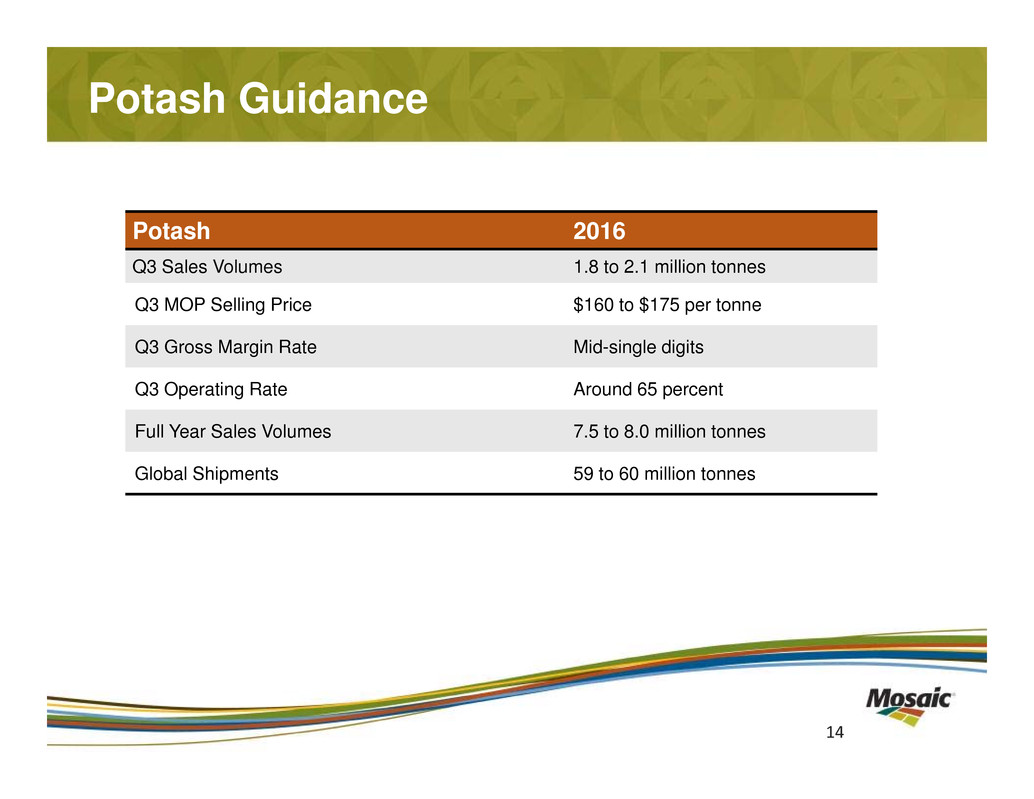
Potash Guidance Potash 2016 Q3 Sales Volumes 1.8 to 2.1 million tonnes Q3 MOP Selling Price $160 to $175 per tonne Q3 Gross Margin Rate Mid-single digits Q3 Operating Rate Around 65 percent Full Year Sales Volumes 7.5 to 8.0 million tonnes Global Shipments 59 to 60 million tonnes 14

Phosphates Guidance Phosphates 2016 Q3 Sales Volumes 2.4 to 2.7 million tonnes Q3 DAP Selling Price $310 to $340 per tonne Q3 Gross Margin Rate Around 10 percent Q3 Operating Rate Around 85 percent Full Year Sales Volumes 9.0 to 9.75 million tonnes Global Shipments 65 to 66 million tonnes 15
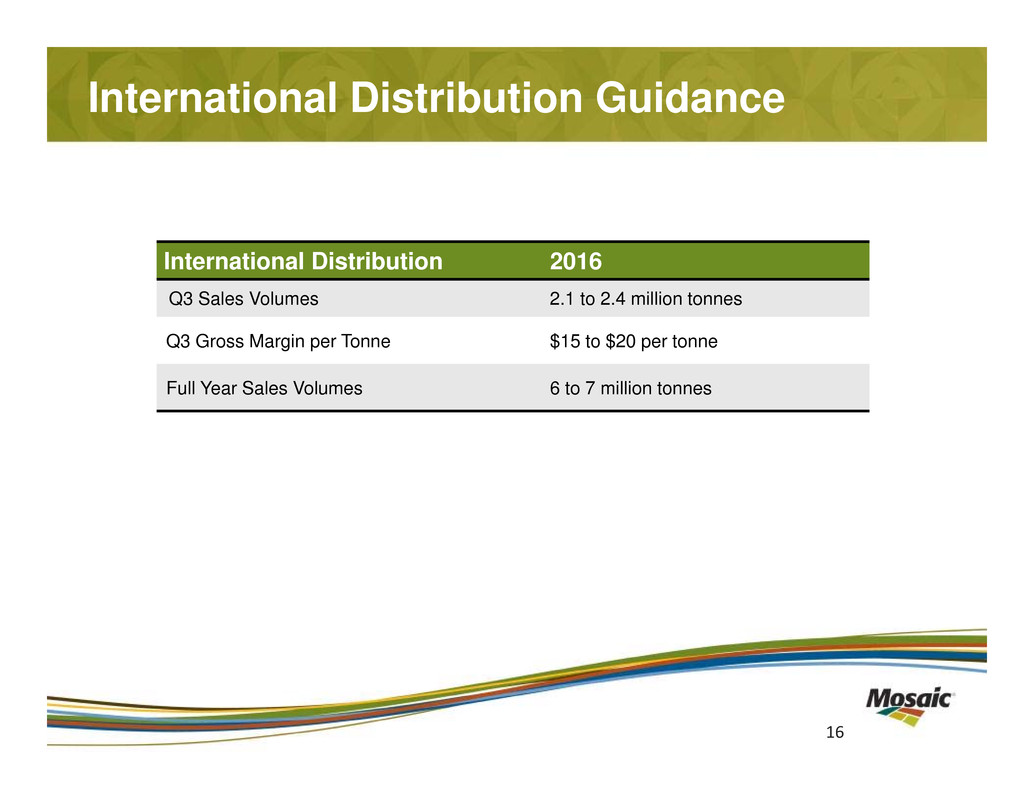
International Distribution Guidance International Distribution 2016 Q3 Sales Volumes 2.1 to 2.4 million tonnes Q3 Gross Margin per Tonne $15 to $20 per tonne Full Year Sales Volumes 6 to 7 million tonnes 16

Full-Year Guidance Summary Consolidated Full-Year 2016 Total SG&A $330 to $350 million Capital Expenditures and Equity Investments $1.0 to $1.1 billion Effective Tax Rate Approximately 10 percent 17 Potash 2016 Full-Year Canadian Resources Taxes (CRT) $95 to $110 million Full-Year Brine Management Costs $150 to $170 million
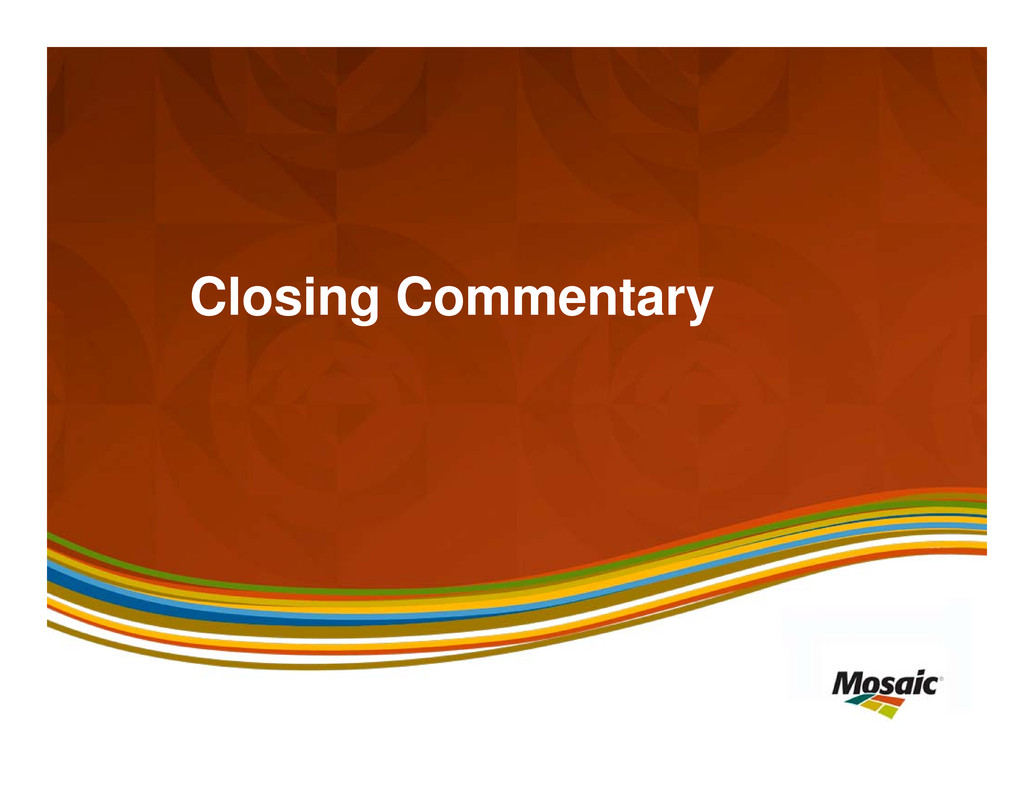
Closing Commentary

Appendix
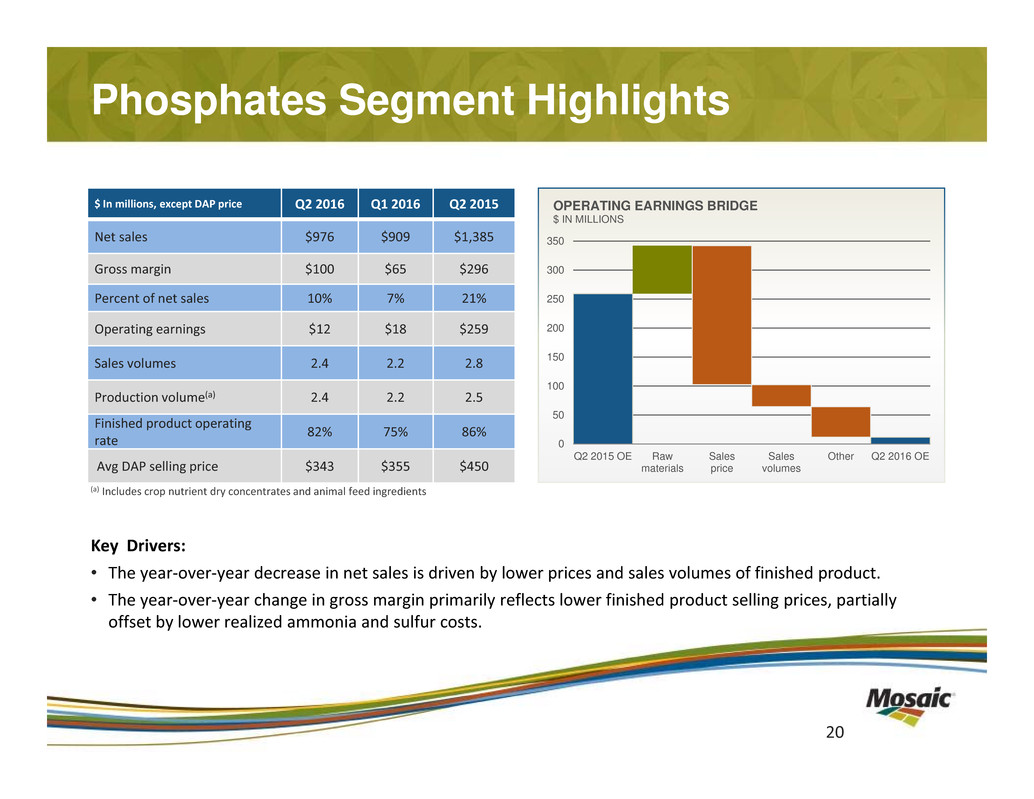
Phosphates Segment Highlights Key Drivers: • The year‐over‐year decrease in net sales is driven by lower prices and sales volumes of finished product. • The year‐over‐year change in gross margin primarily reflects lower finished product selling prices, partially offset by lower realized ammonia and sulfur costs. $ In millions, except DAP price Q2 2016 Q1 2016 Q2 2015 Net sales $976 $909 $1,385 Gross margin $100 $65 $296 Percent of net sales 10% 7% 21% Operating earnings $12 $18 $259 Sales volumes 2.4 2.2 2.8 Production volume(a) 2.4 2.2 2.5 Finished product operating rate 82% 75% 86% Avg DAP selling price $343 $355 $450 (a) Includes crop nutrient dry concentrates and animal feed ingredients 0 50 100 150 200 250 300 350 Q2 2015 OE Raw materials Sales price Sales volumes Other Q2 2016 OE OPERATING EARNINGS BRIDGE $ IN MILLIONS 20

Potash Segment Highlights 21 * Please refer to the press release issued August 2nd, 2016 for discussion of use of non GAAP measures Key Drivers: • The decrease in net sales compared to prior year was driven primarily by lower average realized prices. • The year‐over‐year decrease in gross margin was driven by lower selling prices and volumes. The negative impact of a lower operating rate was offset by benefits from foreign currency and cost savings. $ In millions, except MOP price Q2 2016 Q1 2016 Q2 2015 Net sales $457 $394 $730 Gross margin $53 $98 $295 Percent of net sales 12% 25% 40% Canadian resource taxes (CRT) $38 $18 $55 Gross margin (excluding CRT) $91 $116 $350 Percent of net sales (excluding CRT) 20% 30% 48% Operating earnings $18 $86 $259 Sales volumes 2.0 1.5 2.3 Production volume 1.8 2.0 2.4 Production operating rate 67% 77% 90% Avg MOP selling price $178 $207 280 0 50 100 150 200 250 Q2 2015 OE Sales price Sales volumes Resource taxes & royalties Production and other Q2 2016 OE OPERATING EARNINGS BRIDGE $ IN MILLIONS
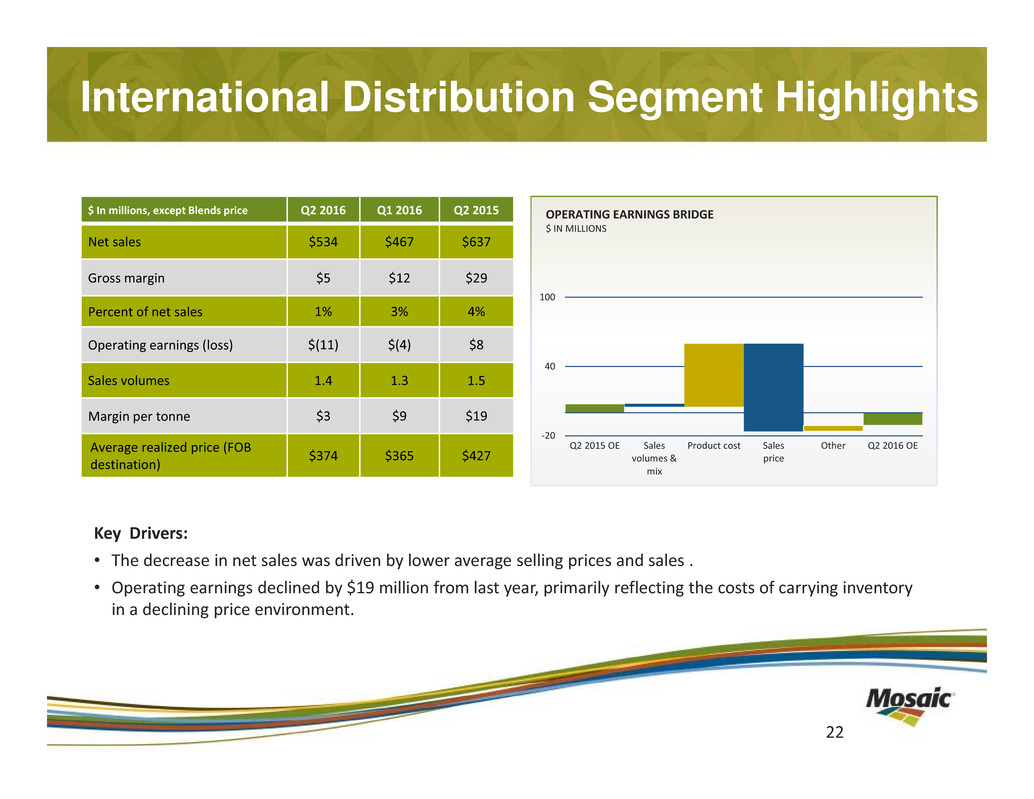
International Distribution Segment Highlights Key Drivers: • The decrease in net sales was driven by lower average selling prices and sales . • Operating earnings declined by $19 million from last year, primarily reflecting the costs of carrying inventory in a declining price environment. 22 $ In millions, except Blends price Q2 2016 Q1 2016 Q2 2015 Net sales $534 $467 $637 Gross margin $5 $12 $29 Percent of net sales 1% 3% 4% Operating earnings (loss) $(11) $(4) $8 Sales volumes 1.4 1.3 1.5 Margin per tonne $3 $9 $19 Average realized price (FOB destination) $374 $365 $427 ‐20 40 100 Q2 2015 OE Sales volumes & mix Product cost Sales price Other Q2 2016 OE OPERATING EARNINGS BRIDGE $ IN MILLIONS

Q2 2016 Percent Ammonia ($/tonnes) Realized in COGS $320 Average Purchase Price $304 Sulfur ($/ton) Realized in COGS $112 Average Purchase Price $98 Phosphate rock (realized in COGS) ('000 tonnes) U.S. mined rock 4,013 92% Purchased Miski Mayo Rock 349 8% Other Purchased Rock 6 0% Total 4,368 100% Average cost / tonne consumed rock $65 Raw Material Cost Detail 23

(a) These factors do not change in isolation; actual results could vary from the above estimates (b) Assumes no change to KMAG pricing Earnings Sensitivity to Key Drivers(a) 24 2016 Q2 Actual Change 2016 Q2 Margin % Actual % Impact on Segment Margin Pre-Tax Impact EPS Impact Marketing MOP Price ($/tonne)(b) $178 $50 12% 21% $97 $0.24 Potash Volume (thousand tonnes) 2,040 500 12% 12% $55 $0.14 DAP Price ($/tonne) $343 $50 10% 13% $122 $0.31 Phosphate Volume (thousand tonnes) 2,449 500 10% 4% $41 $0.10 Raw Materials Sulfur ($/lt) $112 $50 10% 5% $49 $0.12 Ammonia ($/tonne) $320 $50 10% 3% $28 $0.07

Phosphate Raw Material Trends 25 0 25 50 75 100 125 150 175 Q3 2014 Q4 2014 Q1 2015 Q2 2015 Q3 2015 Q4 2015 Q1 2016 Q2 2016 Q3 2016F Realized Costs Market Prices 0 100 200 300 400 500 600 700 Q3 2014 Q4 2014 Q1 2015 Q2 2015 Q3 2015 Q4 2015 Q1 2016 Q2 2016 Q3 2016F Realized Costs Market Prices Ammonia Sulfur ($/tonne) ($/tonne) 1. Market ammonia prices are average prices based upon Tampa C&F as reported by Fertecon 2. Market sulfur prices are average prices based upon Tampa C&F as reported by Green Markets 3. Realized raw material costs include: ~$20/tonne of transportation, transformation and storage costs for sulfur ~$35/tonne of transportation and storage costs for ammonia 1 2

Global Phosphate Shipment Forecasts by Region (August 2, 2016) Source: CRU and Mosaic. Numbers may not sum to total due to rounding. * NPS products included in this analysis are those with a combined N and P2O5 nutrient content of 45 units or greater. Million Tonnes DAP/MAP/NPS*/TSP 2015R Aug Low 2016F Aug High 2016F Aug Low 2017F Aug High 2017F Comments China 19.6 18.8 19.0 19.1 19.5 We again have lowered our 2016 forecast. Spring season shipments were less than expected due to a destocking of channel inventories and a slow start to summer stockpiling. Lower stocks and domestic prices (closer to export values) set the stage for a rebound next year. India 9.2 9.3 9.5 9.4 10.0 Despite starting the year with a large overhang of channel inventories, the above‐average monsoon, high domestic crop prices, and 15% drop in retail DAP prices (thanks to lower international prices, a workable subsidy, and stable rupee) boost our 2016 forecast. Strong demand drivers are expected to carry through to 2017, provided that the rupee remains stable. Other Asia/Oceania 8.7 8.1 8.2 8.3 8.5 We revised modestly higher our expectations for 2016 last quarter due to higher crop prices, more moderate P prices, average to below‐average channel inventories, improved weather prospects (La Niña), and more stable forex rates. Our 2017 forecast calls for a moderate rebound, as we expect the positive drivers to persist. Europe and FSU 5.1 5.1 5.2 5.1 5.3 Our 2016 forecast is unchanged. Big harvests this year imply larger fertilizer replacement requirements, but macroeconomic uncertainties and weaker farm economics in Europe likely will be a drag on growth in 2017. Brazil 6.9 7.4 7.6 7.5 7.7 Near‐record local currency prices for soybeans, corn, sugar, cotton and coffee have led to a big demand pull (Jan‐Jun fertilizer shipments set an all‐time record). Phosphate shipments through the first half of the year are up 12% from a year ago. Volatility of the real remains an issue, but we expect that highly profitable farm economics will continue to drive strong phosphate demand in Brazil in the upcoming peak application season as well as next year. Other Latin America 2.7 3.4 3.5 3.6 3.7 Higher local‐currency ag commodity prices and more moderate fertilizer prices have boosted demand more than previously anticipated in 2016, leading to an upward revision to our forecast, notably in Argentina. Despite calls that Argentina’s soybean export tariff will not be lowered in 2017, we believe that higher corn area will more than offset any impact on phosphate demand. Elsewhere in the region, we believe that solid farm economics will lead to modest to moderate shipment gains. North America 8.9 9.1 9.4 9.0 9.2 2016 shipments were revised up as a result of larger‐than expected spring shipments (including a large de‐stocking of channel inventories) and prospects for a strong fall season. A small drop is projected next year mainly due to an expected decline in U.S. corn acreage. Other 3.6 3.7 3.8 3.8 4.0 Our 2016 forecast is revised slightly higher. Modest growth is expected in the Middle East in 2017, with much stronger (~5% y‐o‐y) growth anticipated in Africa. Total 64.8 64.9 66.2 65.8 67.9 Our 2016 point estimate of 65.6 million tonnes is unchanged from the May forecast. Our initial shipment forecast for 2017 calls for an increase to 66‐68 million tonnes, with a point estimate in the middle of the range ‐‐ a gain of ~2% and in line with the long term trend rate. Source: i . Nu bers ay not su to t t l d t r i .

Global Potash Shipment Forecasts by Region (August 2, 2016) Muriate of Potash Million Tonnes (KCl) 2015 Aug Low 2016F Aug High 2016F Aug Low 2017F Aug High 2017F Comments China 15.9 12.8 13.0 13.7 14.1 Shipments this year are projected to drop more than previously anticipated due to the delayed settlement of 2016 contracts and a drawdown of channel stocks. 1H imports were down 11% from year‐ ago levels. We do not anticipate that changes to government support policies to discourage corn plantings will have a material adverse impact on demand in 2017, with a ~8% rebound to ~14 mmt. India 4.0 4.4 4.6 4.4 4.7 Despite high inventories to start the year, we have upped our forecast for 2016 on the basis of the good monsoon underway, lower potash prices, workable subsidy (which was cut only notionally this year) and strong local ag commodity prices. Our forecast for 2017 calls for bullish demand drivers to continue, though the stability of the rupee remains a wildcard. Indonesia/ Malaysia 4.3 4.5 4.7 5.0 5.2 The rebound in shipments we were expecting in 2016 has been muted, but we believe that fundamentals – better rainfall, lower K prices, and decent rice and palm oil prices – will deliver a more meaningful increase in 2017. Europe and FSU 10.4 10.3 10.5 10.6 10.8 Shipments in 2016 have been revised slightly higher and are now expected to be flat y‐o‐y. Our 2017 forecast calls for a moderate expansion to replace big soil nutrient drawdowns this year and to meet the boost in production of NPKs for export. Brazil 8.7 9.0 9.2 9.2 9.5 Near‐record local currency prices for soybeans, corn, sugar, cotton and coffee have led to a big demand pull (Jan‐Jun fertilizer shipments set an all‐time record).. Potash shipments through the first half of the year are up 16% from a year ago. At the same time, imports are running just 3% ahead of last year and domestic production is off slightly, implying a sizable drawdown in channel inventories. We expect these constructive market conditions to carry over into 2017, underpinning our forecast for shipments to surpass the 2014 high of 9.3 mmt. North America 8.9 8.9 9.1 8.8 9.0 We have trimmed our 2016 forecast slightly due to relatively high channel inventories, though we expect a very solid fall season as a result of large potash withdrawals this year and the low cost of rebuilding soil potassium levels. In 2017, we anticipate a pullback in corn acreage due to lower prices, but that is expected to result in a minor decrease in shipments as acres shift to other crops and the economic incentives to apply potash remain positive. Other 8.9 9.0 9.2 9.4 9.7 Our 2016 forecast is revised slightly higher, as the lower reset in benchmark contract prices (i.e. in China and India) provides a floor in spot market pricing that drives strong demand in the second half of the year. Total 61.2 58.9 60.3 61.1 63.0 Our 2016 global shipments point estimate is little‐changed at 59.6 million tonnes within an unchanged range of 59‐60 mmt. Our initial shipment forecast for 2017 calls for robust demand growth of over 4% to 61‐63 mmt (following two years of negative growth), with a point estimate in the middle of the range. Source: CRU and Mosaic. Numbers may not sum to total due to rounding.


























